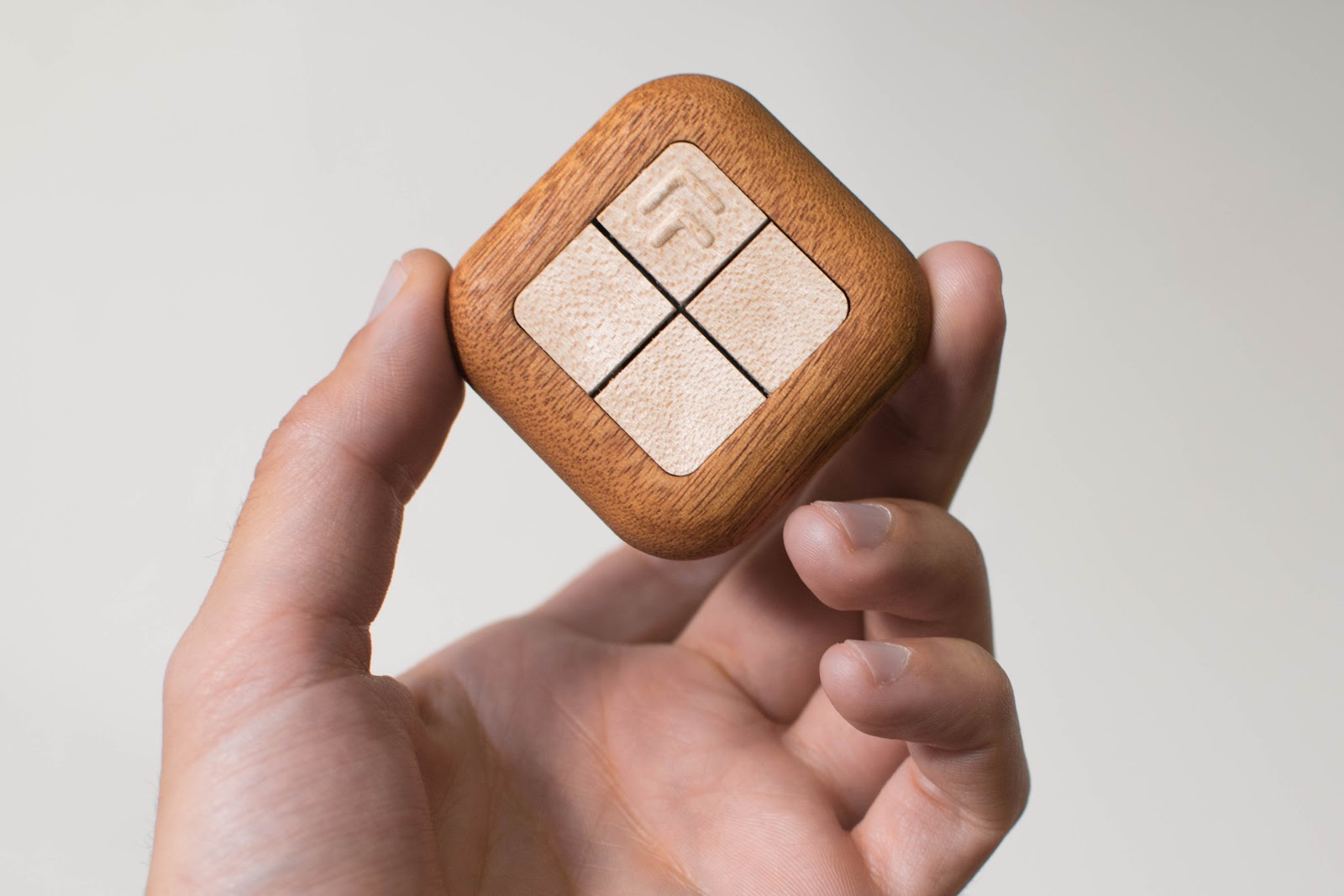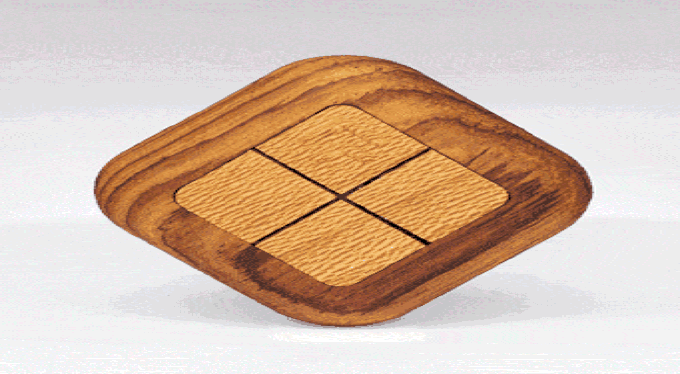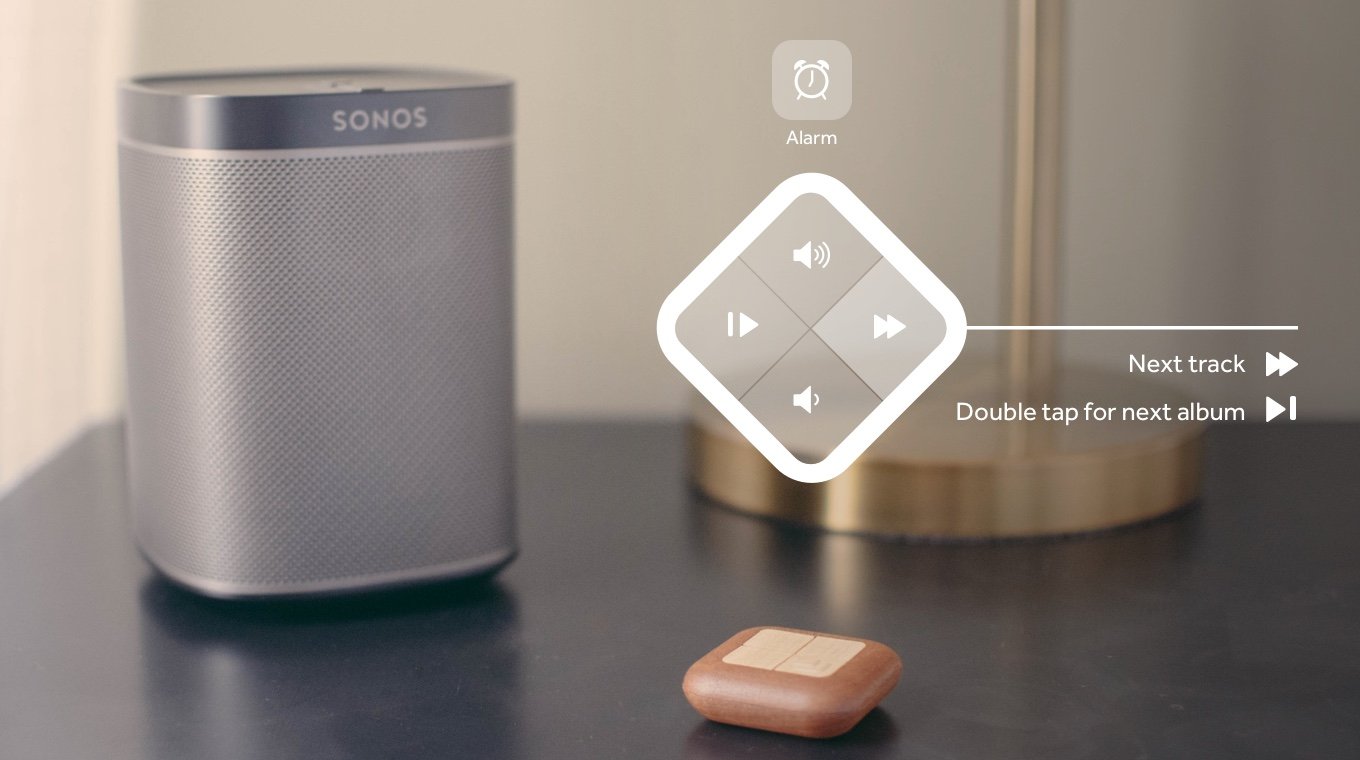How I Created The Turn Touch Remote And Raised $57,000
Hello! Who are you and what are you working on?
I’m Samuel Clay and I designed Turn Touch. Turn Touch is a wooden smart home remote.
Forget plastic, this is a remote as stylish as your home. It controls every smart home device that speaks Wi-Fi. You can also use it to control your Mac and iOS devices over Bluetooth. This includes Keynote, iTunes, Quicktime, Spotify, Sonos, and lots more.
We launched in February 2017 on Kickstarter - and sold over 800 remotes in 30 days. Now in its second production run of 1,000 remotes, two models are sold: mahogany and rosewood.

What's your backstory and how did you come up with the idea?
I came up with the idea for Turn Touch from a need that I had.
I had just received a Philips Hue 3-bulb set and had to use my phone to control them. I wanted to be able to just tap a button and have the colors change to scenes without having to look at my phone.
Meanwhile, I also wanted to have a way to control music playback and volume in iTunes without having to be at the computer.
Putting these two needs together helped me realize that a simple interface could do all of this and more without the need for the complexity of a mouse and keyboard, freeing me to put this “third” interface anywhere in the room.
It was also time for me to learn how to build hardware, specifically hardware made out of wood. The last time I was in a wood shop was in middle school when I built a basic CO2 race car, the kind that runs on a thin rope track.
There’s something comforting about wood that makes me feel like it belongs in the home more-so than anything built out of glass and aluminum.
I was determined to make my remote out of wood and it took about four years of endless prototyping until I emerged with a repeatable process that a machinist could run and reliably produce remotes that could be assembled and then sold.
I did not come into building this product having any expertise other than the discipline that goes into knowing what you want to build and taking it through until the end.
Validating the product was basically achieved by figuring out how big the market was for people who also had smart color bulbs, since I knew that no other remote was on the market that did what mine did.
Smart connected devices are a growing market. My other company NewsBlur, an RSS news reader, is part of a shrinking market. Knowing this, I was determined to enter a nascent but growing market.
Describe the process of designing, prototyping, and manufacturing the product.
In order to make Turn Touch I had to go through two manufacturing processes.
Prototyping
The first was the prototyping stage, which took place at TechShop in San Francisco. Since I knew I wanted to build a remote out of wood, I determined that there were basically four components that I had to learn how to design and build: the circuit board with wireless connectivity, the tactile buttons, the wood case, and the subassembly that mated the wood to the circuit board.
Each of these took about 6-12 months of prototyping and education. I have bins full of circuit boards with different wireless modules (the final circuit board that shipped is revision number 40), imperfect wood cases, and plastic subassemblies that didn’t pass muster.
I split each of these (as well as the mother of pearl inlay on the bottom of each remote) into a four-part DIY guide, complete with source code and documentation, which you can read in full on Medium.
Manufacturing
The second stage after prototyping was production manufacturing and it took a huge time commitment to find the factory that eventually machined the wood cases.
At first, I assumed that I would have to do all my manufacturing in China because that’s just how things are done. So, I traveled to China and set up meetings with six factories of various capabilities in terms of machining wood. I went through a now defunct company that hooked up product designers with manufacturing partners.
For each factory, I met with them and shared my design files and we went over how they thought the parts should be machined. Needless to say, none of them had any experience working with wood designs on such a small scale.

My tolerances during prototyping were accurate to +/- 0.005” and while most CNC machines are capable of meeting that tolerance, the amount of constant maintenance required would mean that my remotes would come out imperfect and not up to my demanding standards.
This experimental approach is the opposite of the conceptual approach that many people assume great products are built with. The assumption is that a great website or great design comes from careful but precise thinking. The truth is that I push out a functional but flawed concept first and then refine it into the shape I want.
Furthermore, after paying each Chinese factory around $250 each for a manufacturing sample, the samples I received were of various qualities and finishes and not a single one perfectly matched my design files.
I knew that in order to push the factories to build to my standard, it would require an immense amount of hands-on labor and time spent in the factory. So I looked elsewhere.
At a craft faire in San Francisco, I spotted a pair of wooden sunglasses that I knew could only be produced on a CNC machine. I inquired and met with the founder of Wood Thumb, a San Francisco based company that produced their own line of wood products for sale in various stores like Williams Sonoma and Crate & Barrel.
We partnered, and I then spent the next year after the Kickstarter campaign successfully funded working on getting the tolerances right and the fixtures to reliably carve out the remotes. They are running the machines as I write this and producing another batch of 1,000 remotes.
It’s not cheap, but considering the cost of getting this right in China, the cost difference is less than you’d think. If I were making something more off-the-shelf the cost difference would be much greater, but due to the unique nature of Turn Touch, it generally cost a great deal no matter where I went.
In the future I would consider making fewer custom components to bring costs down, but that brings its own risks.
Describe the process of launching the business.
The truth is that I still haven’t seen a lot of customers. A thousand remotes sold at $59-$99 each is not a profitable business. I hope to bring those sales figures up, but to do that I have to learn more about marketing and making it clearer how useful a remote like Turn Touch is.
The market dictates everything. It places an upper limit on how much you can sell, how much you can raise, the amount of interest and hunger you’ll see from the press, and the likelihood of finding complements to your product that in turn boost your own product’s success.
Creating the website was straight-forward, as I used a Shopify template and modified it to fit the story I wanted to tell. It also helped that I designed a website before I moved to Shopify and had a better idea of how to tell the story.
This iterative approach shows up a lot in my work, where I start with a flimsy prototype that barely gets the job done and refine it, going through multiple top-to-bottom revisions until I end up in a place where I’m satisfied.
This experimental approach is the opposite of the conceptual approach that many people assume great products are built with. The assumption is that a great website or great design comes from careful but precise thinking. The truth is that I push out a functional but flawed concept first and then refine it into the shape I want.
The launch for the Turn Touch Kickstarter went well considering I was being stretched thin between setting up production and continuing to run my news reader.
I collected a list of publications that covered similar campaigns in the past. Before and during the first week after I launched, I emailed each of about 100 publications a 3 sentence description of the campaign, along with a link to the campaign and the press page, where I collected photos and bullet points that the publications could then easily reuse when writing about Turn Touch.
For the Kickstarter campaign, that was a successful strategy. About a quarter of the publications I reached out to wrote about the remote, such as The Verge, Macstories, The Gadgeteer, 9To5Toys, SlashGear, PSFK, InsideHook, and Digital Trends.
But once a publication wrote about Turn Touch I found that they were unlikely to write about it again once I launched general availability, which hurt my sales figures once I was done fulfilling all of my campaign rewards. I’m still trying to figure out how to get attention again.
Since launch, what has worked to attract and retain customers?
In terms of ad spend, here’s where it gets real... Facebook ads are atrocious.
I spent about $300 per $59 sale, a figure I arrive at after spending about $5,000. I hired two different copywriters in an attempt to find the right audience but nothing has worked with Facebook. I think it comes down to the fact that for Turn Touch a certain amount of educating the consumer is required.
Not only do the customers need to have smart connected devices, but they also need to have the problem of not being satisfied with having to rely on pulling out their phones just to turn off a light. Facebook doesn’t let you target those customers very effectively, so I’m more or less shooting in the dark.

Personally, I’ve bought about half a dozen products off ads in my Facebook feed. Products like a nylon backpack and a pet hair glove practically sell themselves based on the video ad because the only education the consumer needs is how their product is differentiated from a product somebody like me already has in their home.
It’s like the old adage says, first buy a cheap tool and once it breaks then buy the expensive version. These ads target that buying behavior. Unfortunately for Turn Touch, this just isn’t a possibility.
What has worked better has been a targeted community ad like an ad purchased on Daring Fireball. It’s a highly targeting audience of Apple and design fanatics who value a nicely designed product even if it costs a bit more.
I spent $5,000 on an ad that brought in about $10,000 in revenue, thereby breaking even. Not a bad way to go through inventory, but not the multiplier I needed.
I have three more ads in the pipeline with a similar targeted audience, so we’ll see if it pays off or if I need to refine the product landing page to do a better job selling the device.
What I could probably be doing a whole lot better is nurturing my existing customer base and helping them evangelize others into buying the product. But apart from infrequent email newsletters where I announce new features, I haven’t been able to crack that nut.
What are some of the metrics of the business?
I consider Turn Touch to be my first real business. NewsBlur, my first company, has great margins because it’s entirely software based and benefits enormously from the economies of scale inherent in news reading and syndication.
But Turn Touch has actual, material costs of goods sold and margins that are frankly embarrassing. I set my margins pretty low because I wanted to first test to see if there even is a market for a new device like the Turn Touch remote.
I sell Turn Touch for $59 and it costs about $34 to make. Not quite the 2:1 or 3:1 that I would need to be able to sell profitably but not so low that I can’t continue selling them this way indefinitely. My plan is to expand Turn Touch from two models to three with the introduction of a nylon plastic based remote that I’ll sell for $39.
Since the wood consists of about $20 of the COGS, this means that I will be able to make them for approximately $19, giving me a better 2:1 ratio that I will need to stay competitive. I will also plan to manufacture the remote entirely in China, which will bring costs down a bit as well.
Furthermore, I plan on adding some advanced gesture controls using a gyroscope and accelerometer, allowing users to control light brightness and color by rotating the remote and raising it up and down while holding down a button. That way, I can relaunch as a fully redesigned v2 and get more press.
Press being the only reliable way to generate sales. I have not decided whether or not to launch this as a Kickstarter campaign or as an immediate sale, but I’m going to optimize for press as that has consistently been the only way I’ve generated sales.
As for metrics, Shopify says my conversion rate is 1.25%, which is low for a hardware product but not unheard of.
Social media engagement is non-existent and I would love to figure out ways to help push my users into being more vocal about being Turn Touch owners.
I have internal metrics which show that of the 1,000 remotes sold, 66% of them have been successfully setup and used, and of those, a third continue to use their remote regularly after a month.
Through starting the business, have you learned anything particularly helpful or advantageous?
Generally, whenever I think about my business, I think about the market.
The market dictates everything. It places an upper limit on how much you can sell, how much you can raise, the amount of interest and hunger you’ll see from the press, and the likelihood of finding complements to your product that in turn boost your own product’s success.

My first company, an RSS news reader, is part of a shrinking market and I was attuned to that as I made Turn Touch. Home automation is a growing market but it is still nascent.
Few homes have any smart devices at all and name recognition of the brands and products that Turn Touch controls is still close to nil. Part of selling Turn Touch to consumers involves educating them on the types of products it can control and that’s an uphill battle.
Then again, due to the growing market, the press took to the Turn Touch Kickstarter campaign and I had stories published in many of the press outlets I reached out to. A unique product in a new market is quite enticing.
But they’ll only cover you once, so make it good.
What platform/tools do you use for your business?
I really only use Shopify. Everything else I do myself.
I monitor Twitter for mentions try to respond to every single one. I respond to every email and perform my own shipping. When the volume is as low as I have, it’s easy to stay on top of every mention on the web.
A few products have been recommended to me for monitoring social media, but they don’t make sense until I have a monthly volume above what one person can handle in my free time.
Advice for other entrepreneurs who want to get started or are just starting out?
I can’t comment on mistakes others are making, but I sure made a ton of mistakes.
While the campaign was successful, I should have done more to figure out which products users wanted and built to that. I built a number of apps for Turn Touch that nobody but me wanted.
While that’s a fine strategy in some ways, it meant that I spent a lot of developer time building things for an audience of one. That may prove to be beneficial down the road, but for just starting out it would have been a better idea to quality any of my assumptions about what people want.
I enlisted a whole cadre of beta testers, giving out over 100 devices. But wrangling beta testers and getting useful feedback from them is nigh-impossible. At most I got one or the incredibly rare second follow up email from a beta tester.
But after I made changes to address their concerns, unless I emailed them directly (and oftentimes even when I did) I wouldn’t hear back.
It helps to have a community forum that beta testers can go to, and for that I put up a Discourse forum. I wish I put it up on day one of beta testing, but better late than never. Beta user feedback, even as rare as it is, is incredibly productive and makes the hard job of figuring out what people want even harder because it is often counter to the assumptions I made in the first place.
Taking feedback often means going back to the drawing board, but in most cases it’s worthwhile because users will be happy to just tell you what they want, even if it means parsing and normalizing their feedback to fit into the mold of the product.
Two of my competitors do a great job of proactively reaching out and soliciting feedback. I commonly see emails from them asking about new features that launched. I suppose I should probably do that kind of outreach, partially to educate users on what’s new and to also find out if they are using it.
I do have some metrics collected in Metabase that allow me to see what gets used and what doesn’t, but it’s not the same as real feedback.
Where can we go to learn more?
Twitter: @turntouch
Email me at samuel@turntouch.com!
Also, check out the open source Turn Touch 4-part blog series.

Download the report and join our email newsletter packed with business ideas and money-making opportunities, backed by real-life case studies.

Download the report and join our email newsletter packed with business ideas and money-making opportunities, backed by real-life case studies.

Download the report and join our email newsletter packed with business ideas and money-making opportunities, backed by real-life case studies.

Download the report and join our email newsletter packed with business ideas and money-making opportunities, backed by real-life case studies.

Download the report and join our email newsletter packed with business ideas and money-making opportunities, backed by real-life case studies.

Download the report and join our email newsletter packed with business ideas and money-making opportunities, backed by real-life case studies.

Download the report and join our email newsletter packed with business ideas and money-making opportunities, backed by real-life case studies.

Download the report and join our email newsletter packed with business ideas and money-making opportunities, backed by real-life case studies.





